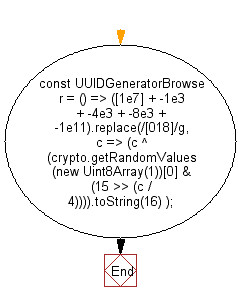
0123456789ABCDEFGHIJKLMNOPQRSTUVWXYZ_abcdefghijklmnopqrstuvwxyz-Īlso, NanoID support 14 different programming languages, which are, C#, C++, Clojure and ClojureScript, Crystal, Dart & Flutter, Deno, Go, Elixir, Haskell, Janet, Java, Nim, Perl, PHP, Python with dictionaries, Ruby, Rust, Swift 4. Instead of having 36 characters in UUID’s alphabet, NanoID only has 21characters.
Uuid generator js generator#
But, NanoID uses crypto moduleand Web Crypto API which is more secure.Īlso, NanoID has used its own algorithm called a uniform algorithm during the implementation of the ID generator instead of using a random % alphabet 3. In most of the random generators, they use unsafe Math.random(). With the application growth, these numbers become visible. For instance, an object using NanoID is small and compact for data transfer and storage. The size reduction directly affects on size of the data. Furthermore, the size limit has been used to reduce the size from another 35%.

Unlike UUID, NanoID is 4.5 times smaller in size and does not have any dependencies. Since NanoID uses a larger alphabet than UUID, a shorter ID can serve the same purpose as a longer UUID. It boils down to the alphabet used by the key. However, the main difference between these two is simple. Caching random data is not always desirable, so as an additional option, the Node.js implementation of crypto.I hope these numbers have already convinced you to try out NanoID. In contrast, crypto.randomUUID() has a mean execution time of only 350 nanoseconds per UUID, with a minimum of 220 and a maximum of 663551. Running on my benchmark server locally, the uuid module has a mean execution time of about 1030 nanoseconds per UUID, with a minimum of 640 and a maximum of 870399. The h1 histogram shows the results for the uuid module. These are the only fixed values in a random UUID - all other bits in the sequence are randomly generated.Ĭopy to Clipboard import ) The reserved field identifies the variant which is encoded into the clock-seq-and-reserved field in the eighth byte in the UUID. As described in RFC 4122, the version is “in the most significant 4 bits of the timestamp (bits 4 through 7 of the time_high_and_version field)”, which - if it’s not clear - are the four most significant bits of the sixth byte in the UUID. The version and reserved fields in the UUID identify the layout and type. Of particular note in this structure are the “version” and “reserved” bits (the time-high-and-version and clock-seq-and-reserved fields in the structure definition above). They actually have a structure as defined by RFC 4122:Ĭopy to Clipboard UUID = time-low "-" time-mid "-" UUIDs aren’t simply a sequence of hex-encoded digits. It’s also worth knowing that uuid module maintainers helped us to review the new API that landed in Node.js core). (It’s important to note that the uuid module is not going anywhere.

So if uuid is ubiquitous, why add uuid generation to Node.js itself?

I’ve never seen a production Node.js application that does not have uuid in its dependency tree, and I consider it to be among the most important dependencies in the ecosystem.
Uuid generator js code#
Historically in Node.js, if you’ve wanted to generate UUIDs, the go-to module on npm has always been the appropriately named uuid module, a small and useful piece of code that is downloaded over 50 million times per week. The irony is that, with the complex definitions and variations that do exist, the random UUID (so-called “version 4 UUIDs”) is by far the most popular and widely used. They don’t realise there’s actually an IETF RFC detailing the construction and format of multiple variations of UUID - all of which share a common serialisation and structure with significant variations on exactly how the bytes are derived. Most developers look at them and assume they’re nothing more than a random sequence of hex-encoded bytes. Universally Unique Identifiers (UUIDs) are surprisingly complex little structures. We introduced you to Node.js’s new Web Cryptography API implementation and the new support for the HKDF key derivation scheme previously, and in this post, we discuss two powerful new capabilities for generating random UUIDs and random prime numbers: Generating random UUIDs Much has been happening in the Node.js crypto subsystem lately. Node.js offers powerful new capabilities for generating random UUIDs and random prime numbers.


 0 kommentar(er)
0 kommentar(er)
